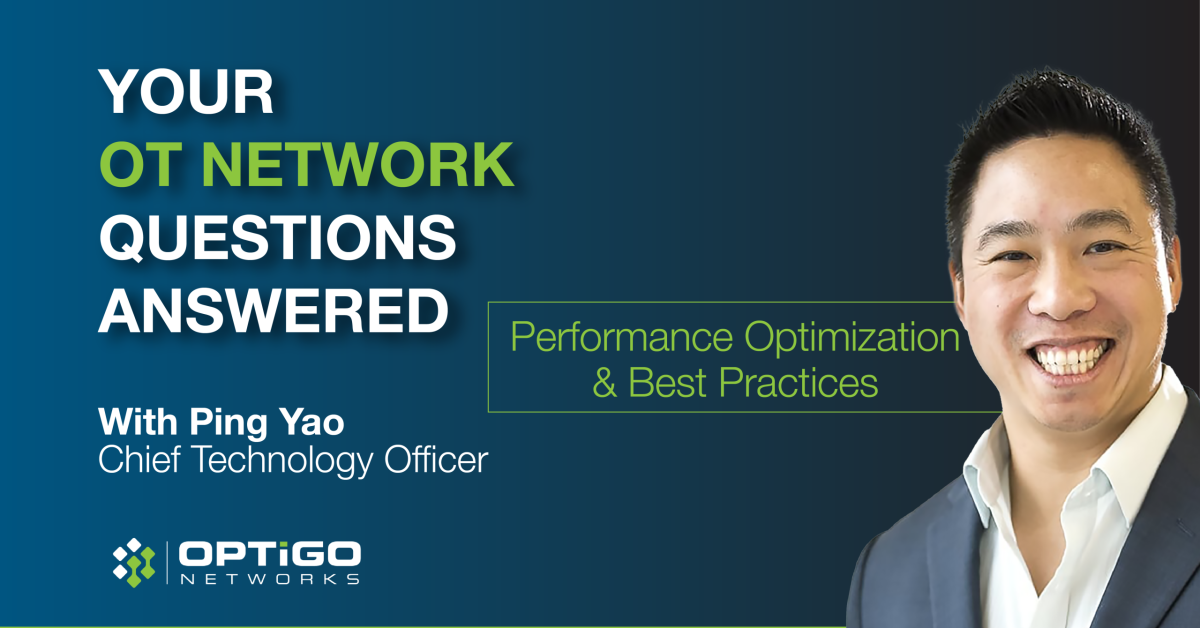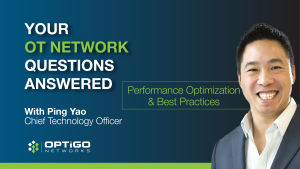This week, in Episode 6, we’re diving into your questions about BACnet’s object model, avoiding configuration mistakes, device‑status checks, whether BACnet is “good,” and BACnet/SC hub behavior. Ping‑Pook Yao, our Co‑Founder & CTO, walks through what to watch for and how to avoid common pitfalls in BACnet/OT networks.
- How do I avoid manual configuration mistakes?
- How many times should I check if a device is online?
- Is BACnet good, or just the least bad option?
Thanks for sending in all your questions! If you’d like us to tackle a particular topic—maybe about broadcast behavior, MS/TP chain length, or network segmentation—send them our way. We love digging deep to help make your BACnet/OT networks more reliable. Send us a message on LinkedIn, Reddit, or Bluesky, or email us at marketing@optigo.net
Send us a message on LinkedIn, Reddit, or Bluesky, or email us at marketing@optigo.net .
Here’s what Ping covers in Episode 6:
❓ BACnet objects, properties, and services — what are they?
BACnet models a system as devices composed of objects (e.g., analog inputs, calendars). Objects have properties (like present value or high limit) and exchange messages via services such as Who‑Is, I‑Am, Read Property, and Subscribe COV.
❓ Any tips to avoid manual configuration mistakes?
Use a spreadsheet and assign clear address ranges by building or vendor to reduce overlap. Then add automation: Optigo Visual Networks (OptigoVN) can watch traffic, build a live device list, reveal unused or conflicting addresses, and spot mis‑set thresholds (like an airflow COV that’s too sensitive). OptigoVN
❓ How many times should I check if a device is online before failing it?
In stable systems, two consecutive non‑responses is enough to flag trouble. On busy networks—especially with MS/TP segments, routers, or BBMDs—latency and bottlenecks can justify slightly more patience before declaring a failure.
❓ Is BACnet “good,” or just the least bad protocol?
The standard is rich and well‑written; issues usually come from how it’s applied. Don’t “discover all” on large systems, and lean on sensible rules and tools. Security has improved with BACnet/SC, but smart implementation remains key.
❓ Will BACnet/SC act like a BBMD bottleneck?
Often yes—and it can be worse, since a BACnet/SC hub commonly carries both broadcast and encrypted unicast traffic. Direct device‑to‑device communication is possible, but only if explicitly configured.
Transcript
Question 1: BACnet objects, properties and services? What are they?
BACnet is an object oriented model.
It represents a BACnet system with a group of “things”.
These things are called “objects.” Every thing, every object, has a list of properties, or attributes—what it is, how it can do things—and then “services” is just a fancy word for saying messages it can transfer between these things.
Keep in mind that a device, like a thermostat or a variable air volume controller, is a group also of objects.
There’s always one special object for every device called a device object.
The other objects, let’s take a thermostat, for example, would have an analog input.
The analog input is where you would plug in this analog sensor that detects a resistance difference when the temperature changes.
And that’s what allows you to detect or to measure the temperature in that room.
It might have a calendar object.
And then every object will have properties again.
So, for example, the present value of the measured analog value would be called a “present value.” You might want to set a high limit.
So if the temperature exceeds this value, then issue an alert.
That would be a “high limit”, and that’s another property.
And then finally, services.
Some examples of services that everyone has heard about: Who-Is, I-Am, the Read Property, Subscribed Change of Value.
These are all services that we can use to exchange messages between these groups of groups of objects.
Question 2: Any tips on how to avoid manual configuration mistakes?
So it is a real thing.
Unfortunately, you know, the tricks are some of the old school tips.
Create a spreadsheet.
Maintain the spreadsheet.
Give buildings a group of addresses so that you reduce the risk of overlap, or give vendors a group of addresses.
Give this vendor every address that they use will start with this number.
You can use tips like if it’s an IP address, you can use a four digit addressing.
If it’s an MS/TP address, use a 6-digit addressing with the chance of going to 7 or 5.
If you have a lot of buildings.
These are tips.
They’re not foolproof, but they do help manage your address scheme.
There’s other configuration mistakes, like forgetting to change a threshold value on a change of value.
There’s not a lot of tricks other than walking through it.
Of course, we at Optigo Networks are encouraging people to automate these checks by using products such as Optigo Visual Networks.
It will be able to watch the traffic and help create dynamically a list of devices.
That way you know what is used, what is not used, any given time in your system.
And they can use that to find the holes and assign an address, or be able to identify things like a change of value that set incorrectly, particularly in things like when you’re measuring airflow and you leave the threshold to 1.
So that means that any kind of change of value of a one CFM — one cubic foot meter — it triggers a lot of change.
Manual configuration mistakes are common.
You do have to develop techniques and processes to reduce them.
Manual checks… and of course, combining that with some automation, using software like Optigo Visual Networks.
Question 3: How many times should I check if the device is online before failing it?
Barring systems that have serious changes or performance issues, in my opinion, if you check twice, and it doesn’t respond twice in a row, that’s sufficient.
I mean, it’s very rare that a system would not reply the first time. And now if you give it a second time, it absolutely should be.
Now, obviously there’s always nuances in these answers.
There’s serious bottlenecks in BACnet systems. Particularly when there’s MS/TP devices involved, BBMDs involved.
These BACnet routers and BBMDs create natural bottlenecks.
As we have talked about many times, BACnet is a very chatty protocol.
It has a lot of broadcast when not maintained. The broadcast goes through everything, which also goes through these routers and BBMDs.
So when you are sending out a ping/checkstatus across these routers, these BBMDs, and it doesn’t reply twice in a row in a system that’s busy? That’s dangerous.
For BACnet MS/TP, you might want to extend that a little bit, especially in systems that you do know have some performance issues.
Q4: Is BACnet “good”, or are we just stuck with the “least bad” protocol?
“BACnet sucks.” I hear that all the time. Or “Do you agree that BACnet is good or bad? Do you think BACnet is good or bad?” It’s a fantastic question, actually.
Let me give you my first answer back.
BACnet is not bad. The standard is very well written, it’s very rich.
The problem is that the BACnet standard allows a lot to be done.
And there’s a saying often when we joke around when we are around the BACnet standard committee table, we say: “Because it can doesn’t mean you should.”
We have to put it in context.
If you think about the context of business, BACnet really allowed this interoperability, this openness between vendors and really extended the growth and allowed this proliferation of building automation and connected devices.
I would say that one of the big weaknesses of BACnet would be on the security side.
And of course, the community has addressed that with BACnet/SC.
But again, the protocol itself is very, very good.
It’s the way it’s applied.
Don’t do a discover-all on a system, a large system.
When you press that discover button on your supervisor, on your job or whatever controller, don’t do a discover from 0 to 4,194,302.
Hopefully that gives you some context.
I think BACnet is an excellent protocol.
We do have to put some rules around it.
As a community, we should continue to advance the tools, the rules, the standard so that we can make it better.
But again, the protocol is very good.
It’s the way we apply it.
We all need to learn to use it better.
Q5: Will BACnet/SC route all the traffic from a network, like a BBMD, through that connection instead?
Ronnie at ABK, thank you so much for the summer wishes and the great question.
The question was, in short: is a BACnet/SC hub fairly equivalent to a BBMD, and therefore does it become a bottleneck, just like how a BBMD becomes a bottleneck for BACnet broadcast messages?
The short answer is yes.
In fact, it is worse, because BACnet BBMDs only route BACnet broadcast messages.
However, in the BACnet/SC context, both broadcast and unicast encrypted messages would go through the hub.
There is one exception: BACnet/SC does allow direct device-to-device communication.
It is again an extra step to configure.
And therefore, without the configuration, all traffic — all BACnet/SC traffic — would go through a single hub.
If you have questions around BACnet systems, how BACnet works on OT networks, how IT and OT work in combination — I would consider us the experts when it comes to that cross section of technology.
Send in your questions and we’ll get to it.
Thank you.





